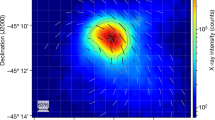Abstract
The fine structure of the active region in the Orion KL gas-dust complex has been measured in polarized H2O maser emission (epoch December 12, 1998) with an angular resolution of 0.15 mas, or 0.07 AU, and a velocity resolution of 0.05 km/s. The maser emission is concentrated in a line with ΔV = 0.45 km/s, V LSR = 7.65 km/s, and a flux density of F = 2.1 MJy. The structure consists of a compact source (ejector), highly collimated bipolar outflow, and a toroidal component. The brightness temperature of the ejector is T b = 2 × 1016 K, and its degree of linear polarization reaches m ≈ 20%. The variation of the polarization angle across the profile is dX/dV = −23°/(km/s), which considerably exceeds the Faraday rotation in the HII region foreground to the molecular cloud. The observed “rotation” is explained as an effect of different orientations for the polarization of the ejected outflows. The brightness temperature of the bipolar outflow is T b ≈ 1014 K, while that of individual components is T b ≈ 1015 K. The degree of polarization in the components exceeds that of the ejector and reaches m ≈ 50%. The position angle of the polarization is X ≈ 45° relative to the outflow. The torus, which is observed edge-on, has a diameter of 0.38 AU and a thickness of 0.08 AU. The brightness temperature of the tangential directions in the torus is T b ≈ 5 × 1015 K, and the rotational velocity is V rot ≈ 0.02 km/s. The degree of polarization is m ≈ 40%, and its position angle relative to the azimuthal plane is X ≈ 43°. The relative deviations of the polarization plane in the bipolar outflow and torus relative to the pumping direction are nearly the same and are determined by Faraday rotation within the HII region.
Similar content being viewed by others
References
I. S. Shklovskii, Astron. Tsirk., No. 372, 1 (1967).
B. F. Burke, K. D. Johnson, V. A. Efanov, et al., Radiofizika, No. 5, 799 (1973).
R. Genzel, D. Downes, J. M. Moran, et al., Astron. Astrophys. 66, 13 (1975).
L. I. Matveenko, Pis’ma Astron. Zh. 7, 100 (1981) [Sov. Astron. Lett. 7, 54 (1981)].
Z. Abraham, N. L. Cohen, R. Opher, et al., Astron. Astrophys. 100, L10 (1981).
G. Garay, J. M. Moran, and A. D. Hashick, Astrophys. J. 338, 224 (1989).
L. I. Matveenko, D. A. Graham, and F. D. Diamond, Pis’ma Astron. Zh. 14, 1101 (1988) [Sov. Astron. Lett. 14, 468 (1988)].
L. I. Matveenko, F. D. Diamond, and D. A. Graham, Pis’ma Astron. Zh. 24, 723 (1998) [Astron. Lett. 24, 623 (1998)].
L. I. Matveenko, K. M. Zakharin, F. D. Diamond, and D. A. Graham, Pis’ma Astron. Zh. 29, 641 (2003).
T. Shimoikura, T. Omodaka, P. J. Diamond, et al., Astrophys. J. 634, 459 (2005).
V. A. Demichev and L. I. Matveenko, Astron. Zh. 81, 1074 (2004) [Astron. Rep. 48, 979 (2004)].
L. I. Matveenko, V. A. Demichev, S. S. Sivakon’, et al., Pis’ma Astron. Zh. 31, 816 (2005) [Astron. Rep. 31, 816 (2005)].
L. I. Matveenko, Pis’ma Astron. Zh. 20, 456 (1994) [Astron. Lett. 20, 388 (1994)].
M.H. Cohen, Proc. IRE 46, 172 (1958).
P. Goldreich, D. A. Keeley, and J. Kwan, Astrophys. J. 179, 111 (1973).
D. A. Varshalovich, Usp. Fiz. Nauk 101, 369 (1970) [Sov. Phys. Usp. 13, 429 (1970)].
L. R. Western and W. D. Watson, Astrophys. J. 285, 158 (1984).
M. Elitzur, Astrophys. J. 416, 103 (1993).
B. E. Turner, in Galactic and Extragalactic Radio Astronomy, Ed. by G. K. Verschuur and K. I. Kellermann (Springer-Verlag, 1988), p. 234.
V. S. Strelnitskij, Mon. Not. Roy. Astron. Soc. 207, 339 (1984).
E. Krugel, in The Physics of Interstellar Dust (Institute of Physics Publishing, Bristol and Philadelphia, 2004), p. 485.
Author information
Authors and Affiliations
Additional information
Original Russian Text © L.I. Matveenko, S.S. Sivakon’, P.J. Diamond, 2006, published in Astronomicheskiĭ Zhurnal, 2006, Vol. 83, No. 12, pp. 1059–1068.
Rights and permissions
About this article
Cite this article
Matveenko, L.I., Sivakon, S.S. & Diamond, P.J. The active region Orion KL in polarized emission in the Orion. Astron. Rep. 50, 951–959 (2006). https://doi.org/10.1134/S1063772906120018
Received:
Accepted:
Issue Date:
DOI: https://doi.org/10.1134/S1063772906120018



